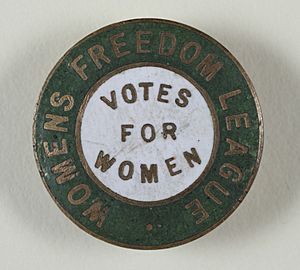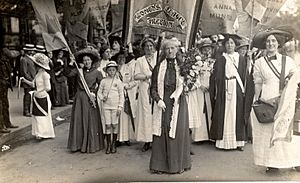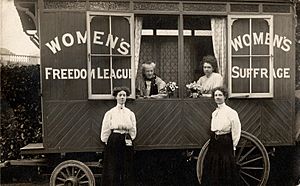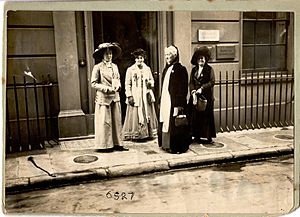Women's Freedom League facts for kids
The Women's Freedom League (WFL) was an important group in the United Kingdom. They worked hard to get women's suffrage, which means the right for women to vote. They also wanted to make sure men and women were treated equally in all parts of life. The WFL started in 1907. It was formed by some members who left another group called the Women's Social and Political Union (WSPU). They left because they disagreed with how the WSPU was being run.
Contents
How the Women's Freedom League Started
The Women's Freedom League was created in 1907. Seventy-seven members from the Women's Social and Political Union (WSPU) started it. These members included Teresa Billington-Greig, Charlotte Despard, Alice Schofield, Edith How-Martyn, and Margaret Nevinson.
They disagreed with Christabel Pankhurst, a leader of the WSPU. She had decided to cancel the WSPU's yearly meeting. She also said that a small group she chose would make all future decisions. The WFL members believed in a more democratic way of making choices.
Peaceful Protests and Growth
The WFL believed in peaceful ways to protest. They did not use violence. Instead, they used methods like refusing to pay taxes. They also refused to fill out census forms, which collect information about people.
The WFL organized many demonstrations. Some members even chained themselves to objects inside the Houses of Parliament. This was to show their strong feelings against the government.
The group grew quickly and had over 4,000 members. From 1909 to 1933, they published their own weekly newspaper called The Vote. This newspaper helped them share their ideas and news with many people.
Important Members and Funding
Sarah Benett was the WFL's Treasurer until 1910. A doctor named Elizabeth Knight later became Treasurer in 1912. She helped the WFL's money situation a lot. Before her, the group sometimes had money problems. Dr. Knight started new ways to raise money. She also gave large donations herself, though she kept it a secret.
In 1912, Nina Boyle became a leader in the WFL's political department. She wrote many articles for The Vote newspaper. Nina Boyle also started a campaign for women to become Special Constables.
Women Police Volunteers
When the First World War started in 1914, Nina Boyle wanted women to help with the war effort. She wanted them to join as volunteers. When the government said no to women becoming official police, Nina Boyle took action.
She teamed up with Margaret Damer Dawson, a wealthy woman who also supported women's rights. Together, they created the first volunteer women's police force. It was called the Women Police Volunteers (WPV).
The WFL During World War I
The Women's Freedom League believed in peace during the First World War. They supported the Women's Peace Council. When the war began, they stopped their campaigns for votes. Instead, they focused on voluntary work to help others.
After the war, in the 1918 United Kingdom general election, some WFL members ran for election. These included Charlotte Despard, Edith How-Martyn, and Emily Frost Phipps. They ran as independent candidates who were against the war and for women's rights. They did not win, but they kept fighting for equality.
After Women Got the Vote
Once women gained the right to vote, the WFL changed its focus. They started working for other types of equality. This included equal pay for men and women. They also worked for equal treatment in society.
The group's membership became smaller over time. However, they continued their work under the leadership of Marian Reeves. They also kept the Minerva Club open in Brunswick Square. After Marian Reeves passed away in 1961, the organization decided to close down.
Protests and Events
The WFL's main goal was to speak out against the government and push for changes. They held protests that supported peace during the First World War. They not only opposed the war but also used only peaceful ways to protest. This included refusing to fill out census forms and not paying taxes.
The Grille Incident
In 1908 and 1909, WFL members chained themselves to objects in Parliament. This was to protest against the government. On October 28, 1908, three WFL members, Muriel Matters, Violet Tillard, and Helen Fox, protested at the House of Commons.
They held up a banner and chained themselves to a metal grille above a window. Police had to remove the grille with the women still attached. Then, they had to file off the locks to free them. This famous protest became known as the Grille Incident.
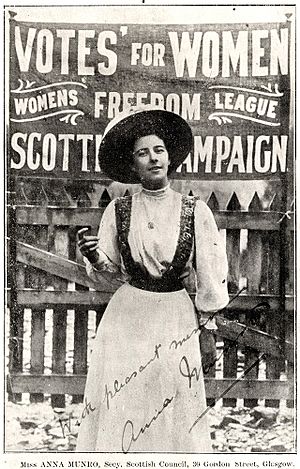
Other Notable Protests
Two WFL members, Alice Chapin and Alison Neilans, protested at voting places during an election in 1909. They damaged ballot boxes to protest the voting system. They were later sent to Holloway Prison.
Suffragette sisters Muriel and Arabella Scott also protested. They chained themselves to their seats at political events in Scotland. They spoke out for the WFL's goals during these events.
The "Brown Women" Walk
The "Brown Women" were a group of six walkers. They were named after the brown coats they wore. Agnes Brown, Isabel Cowe, and four others started a long walk from Edinburgh to London.
They wore white scarves and green hats. As they walked, they collected signatures for a petition asking for women's rights. The hikers walked about fifteen miles each day and attended a meeting every day. It took them five weeks to reach London.
Archives
Records and papers from the Women's Freedom League are kept at The Women's Library. This library is part of the London School of Economics.


